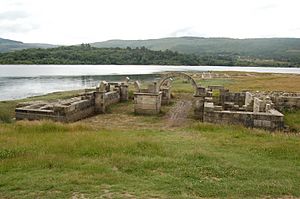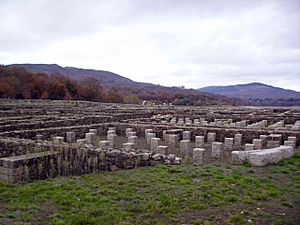Aquis Querquennis facts for kids
Aquis Querquennis is an old Roman fort located in the Ourense Province in Galicia, Spain. It was built a long time ago, around 69-79 AD. Its main job was to house Roman soldiers. These soldiers were busy building an important Roman road called the Via XVIII. The fort was used by a Roman army unit called the Legio VII Gemina. But in 120 AD, these soldiers moved to a place called Dacia, and the fort was left empty.
Many years later, in the 1920s, people rediscovered the fort. A local expert named Florentino López Cuevillas started digging there. However, in 1949, the area was flooded when a big lake, the As Conchas reservoir, was built. Since 1975, whenever the water level in the lake drops, new digs happen at the fort.
Contents
What Was Aquis Querquennis For?
This Roman fort was a home for Roman soldiers. They were working hard to build the Via XVIII. This important road connected two major Roman cities: Bracara Augusta (which is now Braga, Portugal) and Asturica Augusta (now Astorga, Spain).
The fort could hold about 500 soldiers. These included both foot soldiers and cavalry (soldiers on horseback). They belonged to a part of the Legio VII Gemina army unit. Their main base was in a city now known as León, Spain. The fort was used for about 50 years. When the soldiers moved to Dacia in 120 AD, the fort was no longer needed.
Discovering the Past: Archaeology at the Fort
The fort of Aquis Querquennis was forgotten for many centuries. Then, in the 1920s, it was found again. An archaeologist named Florentino López Cuevillas led the first excavations.
In 1949, a big project created the As Conchas reservoir. This caused the fort site to be covered by water. But parts of the fort become visible when the water level of the reservoir goes down. Since 1975, archaeologists have been able to dig and study the exposed areas.
In the 1980s, special aerial photos showed the full size of the fort. It covers about 2.4 hectares (that's like 6 football fields!). It's believed to be one of the biggest Roman army camps in Iberia (Spain and Portugal).
What Have Archaeologists Found?
During the digs, many parts of the fort have been uncovered. These include:
- A headquarters building, where the leaders worked.
- Two granaries, which were storage buildings for grain.
- A hospital, to care for sick or injured soldiers.
- Five barracks, where the soldiers slept.
- A mansio, which was like a guesthouse for important travelers.
They also found roads, drains, walls, towers, and gates. There was even a road that went all around the edge of the fort. Because of its large size, local people sometimes call the site "A cidá," which means "the city."
In 2018, Aquis Querquennis was named a Bien de Interés Cultural. This means it's a very important cultural site. There is also a museum nearby, called the Aquae Querquennae-Vía Nova Interpretation Center. It teaches visitors about the road and the fort. The site is also close to natural hot springs and old Roman bathhouses at O Bano. In August 2022, the entire fort was visible when the reservoir water levels dropped very low.
See also
 In Spanish: Aquis Querquennis para niños
In Spanish: Aquis Querquennis para niños



